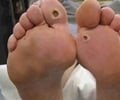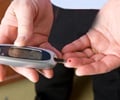Diabetic foot infections are the most common problem which can result in lower extremity amputations.

Because people with diabetes often have poor circulation and little or no feeling in their feet, a sore caused by a rubbing shoe or a cut can go unnoticed and worsen. As many as one in four people with diabetes will have a foot ulcer – an open sore – in their lifetime. These wounds can easily become infected. Unchecked, the infection can spread, killing soft tissue and bone. Dead and infected tissue must be surgically removed, which, if the infection is extensive, can mean amputation of the toe, foot, or even part of the leg. Nearly 80 percent of all nontraumatic amputations occur in people with diabetes – and 85 percent of those begin with a foot ulcer.
"Lower extremity amputation takes a terrible toll on the diabetic patient," said Benjamin A. Lipsky, MD, chair of the review panel, lead author of the guidelines and professor of medicine at the University of Washington and VA Puget Sound, Seattle. "People who have had a foot amputated often can no longer walk, their occupational and social opportunities shrink, and they often become depressed and are at significant risk for a second amputation. Clearly, preventing amputations is vital, and in most cases, possible."
The guidelines emphasize the importance of rapid and appropriate therapy for treating infected wounds on the feet, typically including surgical removal (debridement) of dead tissue, appropriate antibiotic therapy and, if necessary, removing pressure on the wound and improving blood flow to the area. Many patients with foot infections initially receive only antibiotic therapy, which is often insufficient in the absence of proper wound care and surgical interventions, the guidelines note.
Because treatment of diabetic foot infections can be complicated, the best approach is to involve a multidisciplinary team that can assess and address various aspects of the problem, suggest the guidelines, which are a revision and update of IDSA's 2004 diabetic foot infections guidelines. Research since the previous guidelines shows that many foot infections are treated improperly, including prescribing the wrong antibiotic or not addressing underlying conditions such as peripheral arterial disease.
The new guidelines include 10 common questions with extensive, evidence-based answers, which the panel that wrote the guidelines determined were most likely to help a health care provider treating a patient with diabetes who has a foot wound. The first step is to determine if the wound is infected, which the guidelines note is likely if there are at least two of the following signs: redness, warmth, tenderness, pain or swelling. About half of ulcers are not infected and therefore should not be treated with antibiotics, the guidelines note. People with infections do need antibiotic therapy and those with a severe infection should be hospitalized immediately.
Advertisement
"There is quite a bit of over-prescribing or inappropriate prescribing of antibiotics for diabetic foot wounds, which doesn't help the patient and can lead to antibiotic resistance," said Warren S. Joseph, DPM, co-author of the guidelines and consultant for lower extremity infectious diseases at Roxborough Memorial Hospital, Philadelphia. "The guidelines note that when antibiotics are necessary they should be discontinued when the infection is gone, even if the wound hasn't completely healed."The voluntary guidelines are not intended to take the place of a doctor's judgment, but rather to support the decision-making process, which must be individualized according to each patient's circumstances.
Advertisement















